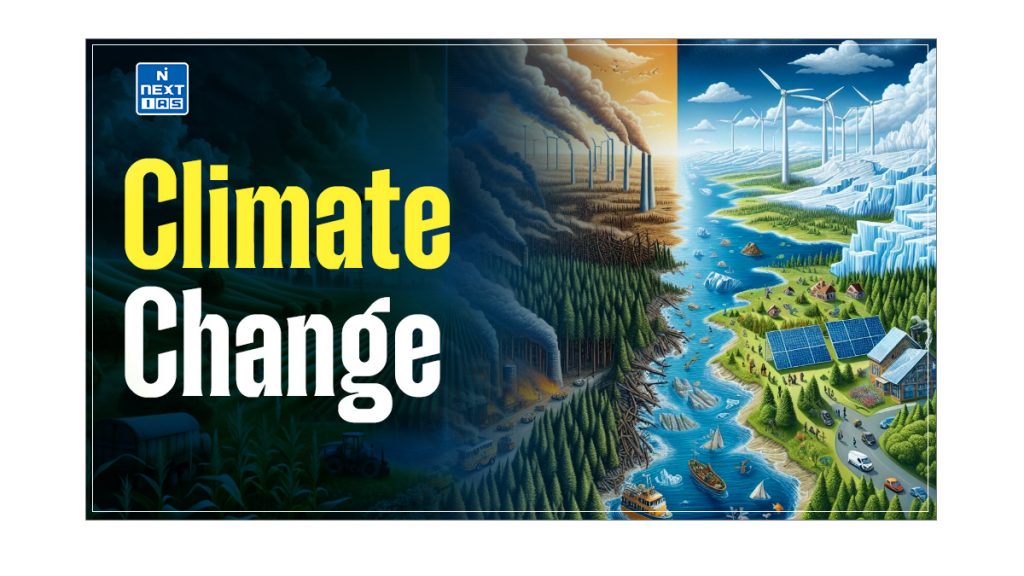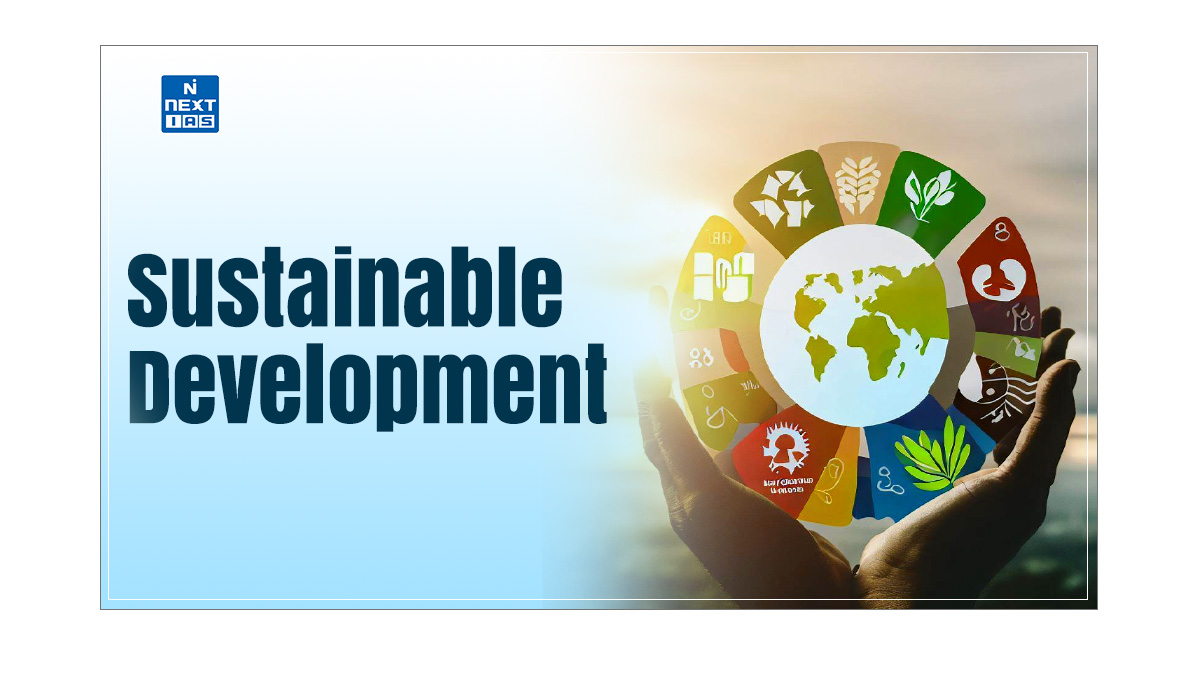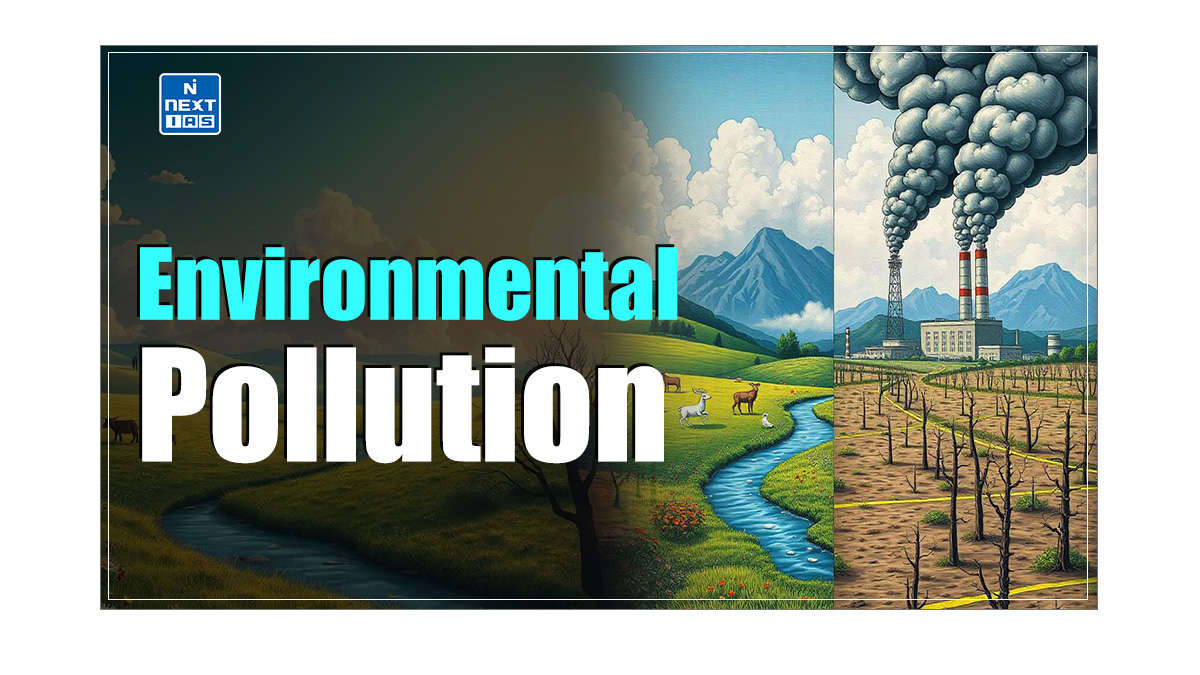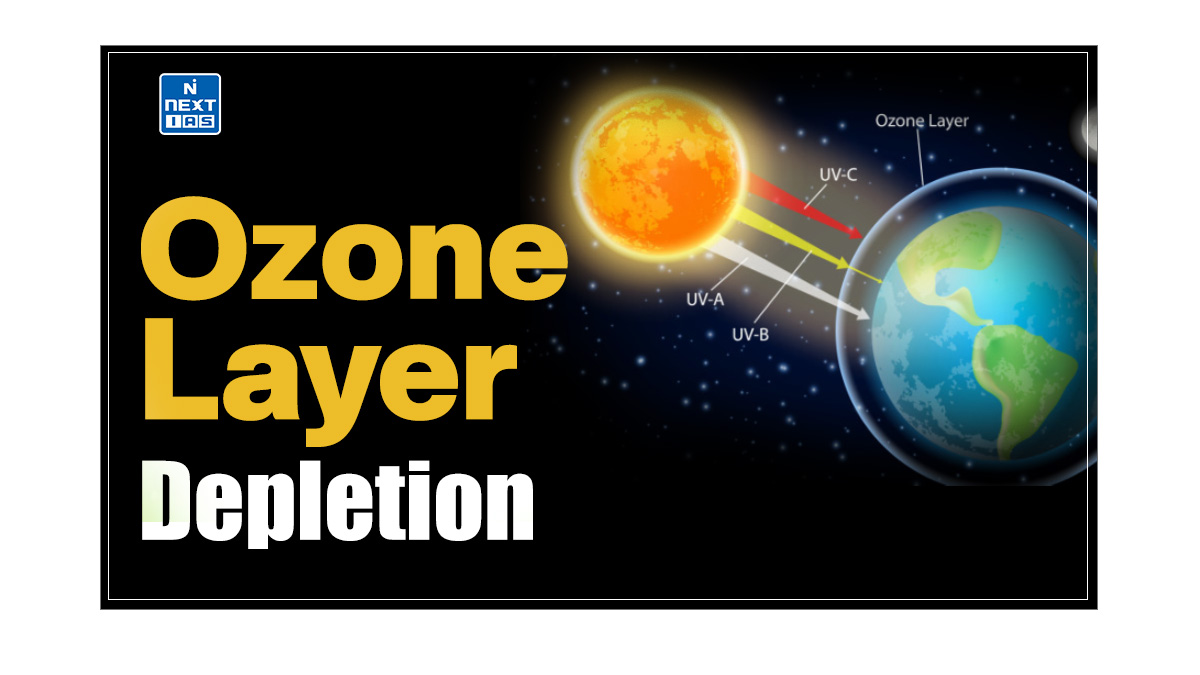
Climate Change is one of the most pressing challenges of the 21st century, affecting every region, ecosystem, and aspect of human life. Its widespread impacts mean that it has become a critical environmental and socio-economic issue. This article aims to study in detail Climate Change, its evidences, major causes, impacts on India and the world, and other related concepts such as Climate Forcings.
What is Climate Change?
- Climate change means a significant change in climate measures, such as temperature, rainfall, or wind, lasting for an extended period—decades or longer.
- It is a term that describes a long-term change in the Earth’s climate.
- The Earth’s climate has changed many times during the planet’s history, with events ranging from ice ages to long periods of warmth.
- The current warming trend is of particular significance because most extremes will likely result from human activity since the mid-20th century and proceed at an unprecedented rate over decades to millennia.
- Evidence reveals that current warming is occurring roughly ten times faster than the average rate of ice-age-recovery warming.
Types of Climate Change
The types of climate change can be seen as follows:
- Global Warming: It refers to the long-term increase in Earth’s average surface temperature due to human activities, primarily the burning of fossil fuels, which releases greenhouse gases like carbon dioxide (CO₂) and methane (CH₄) into the atmosphere.
- Ocean Acidification: It occurs when excess CO₂ is absorbed by oceans, leading to a decrease in pH levels. This negatively impacts marine life, particularly organisms like corals and shellfish that rely on calcium carbonate for their structures.
- Extreme Weather Events: It includes an increase in the frequency and intensity of weather phenomena such as hurricanes, droughts, heatwaves, floods, and wildfires. Climate change exacerbates these events, causing significant damage to ecosystems and human infrastructure.
- Changes in Precipitation Patterns: It involves alterations in the distribution, intensity, and duration of rainfall. Some regions may experience heavier rainfall, leading to flooding, while others may face prolonged dry spells, resulting in droughts.
- Melting Polar Ice and Glaciers: It refers to the accelerated melting of ice sheets in Greenland and Antarctica, as well as glaciers worldwide. This contributes to rising sea levels, which threaten coastal communities and ecosystems.
Evidences of Climate Change
Earth-orbiting satellites and other advances in technologies have enabled scientists to collect different types of information about our planet and its climate on a global scale. Some of the most prominent evidences of climate change are listed below:
- Atmospheric Evidences
- Global Temperature Rise: Since 1900, Earth’s average surface air temperature has increased by about 0.8°C, with much of this increase taking place since the mid-1970s.
- Increased Weather Extremities
- Torrential Downpours
- Acid Rain
- Air Quality
- Hydrospheric Evidences
- Warming of Oceans
- Rising Sea Levels
- Ocean Salinity and Acidification
- Changes to the Ocean’s Major Current Systems
- Poleward shifts of temperature-sensitive species of fish, mammals, insects, etc.
- Cryospheric Evidences
- Shrinking Ice Sheets, such as reduced Arctic Sea ice extent
- Decreased Snow Cover
- Decreasing Glaciers
Causes of Climate Change
Forces that contribute to climate change include both natural and anthropogenic factors.
Natural Causes
Some of the prominent natural causes of climate change are as follows:
- Continental Drift
- The continental drift i.e. movement of landmasses had an impact on the climate because it changed the physical features of the landmass, their position and the position of water bodies.
- The separation of the landmasses changed the flow of ocean currents and winds, which affected the climate.
- Volcanoes
- When a volcano erupts, it throws out large volumes of Sulphur dioxide (SO2), water vapour, dust, and ash into the atmosphere, which can influence climatic patterns for years.
- The gases and dust particles can reach to the upper atmosphere, and partially block the incoming rays of the sun, leading to cooling.
- Sulphur dioxide combines with water to form tiny droplets of sulphuric acid, thus causing Acid Rain.
- Earth’s Tilt
- The Earth is tilted at an angle of 23.5° to the perpendicular plane of its orbital path around the Sun.
- Changes in this tilt can affect the severity of the seasons – more tilt means warmer summers and colder winters; less tilt means cooler summers and milder winters.
- The Earth’s axis around the Sun moves at the rate of a little more than a half-degree each century.
- This gradual change in the direction of the earth’s axis, called precession, is responsible for changes in the climate.
- The Earth is tilted at an angle of 23.5° to the perpendicular plane of its orbital path around the Sun.
- Ocean Currents
- Ocean currents move vast amounts of heat across the planet. Certain parts of the world are influenced by ocean currents more than others.
- Much of the heat that escapes from the oceans is water vapour, Earth’s most abundant greenhouse gas.
Human Causes
- The Industrial Revolution saw the massive use of fossil fuels such as oil, coal, natural gas, etc. for industrial activities. This has contributed to a rise in greenhouse gases in the atmosphere and, hence, Global Warming.
- The energy sector is responsible for large-scale emissions of carbon dioxide, methane, and a large quantity of nitrous oxide.
- It also produces nitrogen oxides (NOx) and carbon monoxide (CO), which are not greenhouse gases but do influence the chemical cycles in the atmosphere that produce or destroy them.
Effects of Climate Change
The impacts of climate change are evident across regions and in many sectors that are important to society. The same can be seen as follows:
Global Effects
- Climate change impacts crop yields, as crop yield depends on the raw material affected by the climate change.
- For example, climate change affects water availability for irrigation and increases pest attacks, affecting crop growth and productivity.
- A 2°C rise in global mean temperatures by 2100 will gravely upset the current farming systems.
- It has increased the frequency of extreme weather events.
- For example, increasing uncertainty in rainfall has increased the incidences of climate change-related droughts and floods.
- The Climate change impacts on livestock production are likely to be in two folds:
- Productivity losses are owing to temperature increases and
- Changes in the availability, quality, and prices of inputs such as fodder, disease management, and water.
- Climate change increases the water temperature, intensifying water pollution problems and negatively affecting aquatic habitats.
- Also, the rate of evapotranspiration increases due to a rise in surface water temperature, resulting in the shrinking of some water bodies.
- Climate change is raising sea levels. In 2013, the IPCC estimated an increase of between 30 cm and 100 cm by the year 2100.
- This, then, has multiple negative effects, such as a threat to vital infrastructure, salination of inland freshwater resources, damage to agriculture due to increased salinity of soil, etc.
- Changes in climate have ill consequences for ecosystems and biodiversity, such as the extinction of some species and increased acidification of water resources.
- Climate change threatens human health and well-being in numerous ways, such as increased incidences of heatstrokes and vector-borne diseases.
- According to a WHO report, in a period spanning 2030 and 2050, climate change may cause approximately 2,50,000 additional deaths per year from malnutrition, malaria, diarrhoea and heat stress.
Effects on India
- Most of the agriculture in India is rainfall-dependent, which will become uncertain, causing frequent droughts and floods due to climate change.
- The increased uncertainty in rainfall is also causing issues such as increased desertification, a decrease in arable land & erosion of soil due to flooding, etc.
- India has a long coastline that will be impacted by rising sea levels and inundated coastal arable lands.
- This will cause a significant loss in India’s marine food system.
- There has been a significant reduction in freshwater resources across the nation due to climate change.
- With the shrinking of the Himalayan glaciers, perennial rivers are changing their courses, causing floods and damage to infrastructure.
- The problem of water quality may be exacerbated by climate change.
- Change in climate has also increased instances of water-borne as well as vector-borne diseases such as malaria, yellow fever, etc.
- Extreme weather events such as severe storms, floods, drought, extreme cold waves and heat waves have claimed thousands of lives during the last few years and have adversely affected the lives of millions and have increased costs significantly in terms of economic losses and damage to property.
Read our detailed article on the Impacts of Climate Change.
International Efforts to Mitigate Climate Change
Some of the important international efforts to mitigate climate change can be seen as follows:
- International Organisations
- UN Framework Convention on Climate Change (UNFCCC): It provides a forum for negotiating international agreements to address climate change.
- Intergovernmental Panel on Climate Change (IPCC): It provides scientific assessments on climate change, serving as a crucial resource for policymakers.
- International Agreements
- Paris Agreement (2015): It aims to limit global warming to well below 2 degrees Celsius above pre-industrial levels.
- Kyoto Protocol (1997): It established legally binding emission reduction targets for developed countries.
- International Programs
- Reducing Emissions from Deforestation and Forest Degradation (REDD) and REDD+: They provide a set of steps designed to use market/financial incentives in order to reduce the emissions of greenhouse gases from deforestation and forest degradation.
- Clean Development Mechanism (CDM): It has been developed under the Kyoto Protocol as a mechanism to allow developed countries to invest in emission reduction projects in developing countries.
- Sustainable Development Goals (SDGs): Some of the SDGs, such as SDG-13, aid in tackling climate change and its ill effects.
- Other International Efforts
- Technological Advancements: Investments are being made in developing technologies, such as renewable energy, Carbon Capture and Storage (CCS), etc.
- Public Awareness and Engagement: Initiatives like Earth Hour are being organised to enhance public awareness on the issue of climate change.
India’s Efforts to Mitigate Climate Change
- National Policies and Strategies
- National Action Plan on Climate Change (NAPCC): This comprehensive plan outlines eight missions to address climate change, including renewable energy, sustainable development, and climate resilience.
- Intended Nationally Determined Contributions (INDCs): India has committed to reducing its greenhouse gas emissions intensity by 33-35% below 2005 levels by 2030.
- National Electric Mobility Mission Plan: This plan aims to promote electric vehicles and reduce dependence on fossil fuels.
- National Programs
- Promotion of Renewable Energies: Several national programs, such as the National Solar Mission, Ethanol Blending Program, etc, aim to promote renewable energy.
- Afforestation and Reforestation: India has undertaken massive afforestation and reforestation programs to increase forest cover.
- Energy Efficiency: India is implementing energy-efficient technologies and policies to reduce energy consumption.
- International Cooperation
- International Solar Alliance (ISA): India co-founded the ISA to promote solar energy cooperation among developing countries.
- Climate Finance: India is actively seeking climate finance from international sources to support its climate mitigation and adaptation efforts.
Way Forward
- Integrating climate change into policy processes and decision-making across a range of sectors and scales.
- Widen observational networks for sustained monitoring of climate and its impacts.
- For example, a network of tide gauges can be established along the Indian coastline to monitor changes in sea level.
- A detailed, regional-specific climate change risk assessment should be done.
- This will help develop region and sector-specific mitigation and adaptation strategies.
- Incentivising deep decarbonisation in hard-to-abate industrial sectors like cement, steel, aluminium, copper, etc
- Increased focus on afforestation.
- Continued push to green energy and energy efficiency in energy-intensive sectors. e.g. transport, industries, etc.
- Mobilise international support to secure funds and green technologies from developed countries.
- Economic and social development at all levels needs to be undertaken with an eye to ensure that it is ‘climate proof’ and ‘climate-friendly’.
Conclusion
Climate change is an environmental issue and a socio-economic and political challenge that requires immediate and sustained action. The scientific consensus on the causes and consequences of climate change underscores the need for coordinated international efforts, innovative technologies, and inclusive policies. While progress has been made, much more needs to be done to mitigate the worst impacts of climate change, adapt to its inevitable effects, and safeguard the future for generations to come.
Climate Forcings
- A climate forcing or climate driver is any influence on climate that originates from outside the climate system.
- These forcings contributed to climate change in a significant way.
- Based on different parameters, Climate Forcings can be classified into various types, as can be seen below:
Natural Climate Forcings and Human-induced Climate Forcings
Natural Climate Forcings
- Natural climate drivers include changes in the sun’s energy output, regular changes in Earth’s orbital cycle, and large volcanic eruptions that put light-reflecting particles into the upper atmosphere.
- Natural fluctuations in solar output (solar cycles) can cause changes in the energy balance through fluctuations in the amount of incoming Solar Wave radiation.
- Some prominent examples of Natural Climate Forcings include:
- An increase in the luminosity of the sun
- A very large volcanic eruption can increase the aerosol in the lower stratosphere, which reflects sunlight into space.
Human-induced Climate Forcings
- Human-caused or anthropogenic climate drivers include emissions of heat-trapping gases (also known as greenhouse gases) and changes in land use that make land reflect more or less sunlight energy.
- Since 1750, human-caused climate drivers have been increasing, and their effect dominates all natural climate drivers.
- Anthropogenic changes in GHGs (e.g., CO2, CH4, N2O, O3, CFCs) and large aerosols (> 2.5 µm in size) modify the amount of outgoing LWR by absorbing outgoing LWR and re-emitting less energy at a lower temperature.
- Some prominent examples of Human-Induced Climate Forcings include:
- The gases and aerosols produced by fossil fuel burning
- Alterations of Earth’s surface from various changes in land use, such as the conversion of forests into agricultural land.
Positive Climate Forcings and Negative Climate Forcings
Positive Climate Forcings
- Positive Radiative Forcing means Earth receives more incoming energy from sunlight than it radiates to space, hence causing global warming.
- For Example:
- An increase in the luminosity of the sun is a positive forcing that tends to make Earth warmer;
- The presence of excess greenhouse gases tends to prevent this heat radiation from escaping to space, leading eventually to a warming of Earth’s surface.
Negative Climate Forcings
- Negative Radiative Forcing means that Earth loses more energy to space than it receives from the sun, which produces cooling.
- For Example:
- A very large volcanic eruption increases the amount of aerosols (fine particles) in the lower stratosphere (altitudes of 10–15 miles) that reflect sunlight to space and thus reduce the solar energy delivered to Earth’s surface.
- Exhaust from high-sulphur coal produces light aerosol that reflects sunlight back to space, leading to a cooling effect.
Frequently Asked Questions (FAQs)
What is Climate Change?
Climate change refers to significant and lasting changes in the average temperature and weather patterns of Earth over extended periods. It encompasses both natural variations and human-induced changes, primarily driven by the increase of greenhouse gases in the atmosphere.
What are the main causes of climate change?
The main causes of climate change include:
Greenhouse Gas Emissions
Deforestation
Agricultural Practices
Industrial Processes
How to prevent climate change?
Preventing climate change involves reducing greenhouse gas emissions, transitioning to renewable energy sources, increasing energy efficiency, promoting sustainable transportation, and protecting forests and biodiversity. Individual actions, such as reducing waste and conserving energy, also play a crucial role.
How to stop climate change?
To stop climate change, we must rapidly reduce greenhouse gas emissions by transitioning to renewable energy, implementing energy-efficient practices, and adopting sustainable land-use strategies while fostering global cooperation and commitment to climate action.






